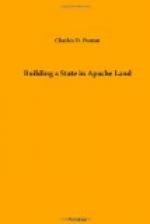How the Territory Was Acquired
In San Francisco in the early fifties, there was a house on the northeast corner of Stockton and Washington, of considerable architectural pretensions for the period, which was called the “Government Boarding House.”
The cause of this appellation was that the California senators and their families, a member of Congress and his wife, the United States marshal, and several lesser dignitaries of the Federal Government, resided there. In those early days private mansions were few; so the boarding-house formed the only home of the Argonauts.
After the ladies retired at night, the gentlemen usually assembled in the spacious parlor, opened a bottle of Sazerac, and discussed politics.
It was known to the senators that the American minister in Mexico had been instructed to negotiate a new treaty with Mexico for the acquisition of additional territory; not that there was a pressing necessity for more land, but for reasons which will be briefly stated:
1st. By the treaty of 1848, usually called Guadaloupe Hidalgo,[A] the government of the United States had undertaken to protect the Mexicans from the incursions of Indians within the United States boundary, and as this proved to be an impractical undertaking, the damages on account of failure began to assume alarming proportions, and the government of the United States was naturally anxious to be released from the obligation.
2. The Democratic party was in the plenitude of power, and the Southern States were dominant in the Administration. It had been the dream of this element for many years to construct a railroad from the Mississippi River to the Pacific Ocean, and the additional territory was required for “a pass”. It was not known at that early day that railroads could be constructed across the Rocky Mountains at a higher latitude, and it was feared that snow and ice might interfere with traffic in the extremes of winter.
The State of Texas had already given encouragement to the construction of such a railroad, by a liberal grant of land reaching as far west as the Rio Grande, and it devolved upon the United States to provide the means of getting on to the Pacific Ocean. The intervening country belonged at that time to Mexico, and for the purpose of acquiring this land the treaty was authorized.
The condition of affairs in Mexico was favorable to a negotiation. Santa Ana had usurped the powers of the government, and was absolute dictator under the name of President. There was no Mexican Congress, and none had been convened since they were herded together at the conclusion of the Mexican War under protection of American troops.
The condition of affairs in the United States was also extremely favorable. The treasury was overflowing with California gold, under the tariff of 1846 business was prosperous, the public debt small, and the future unclouded. The American Minister to Mexico (General Gadsden of South Carolina) was authorized to make several propositions:—




